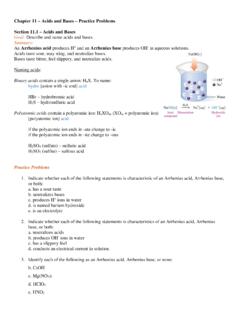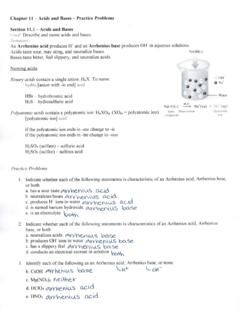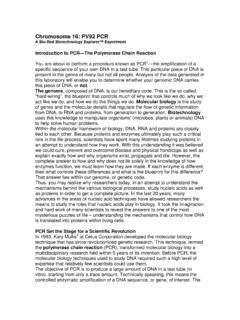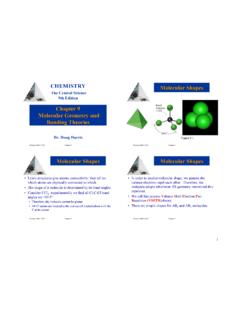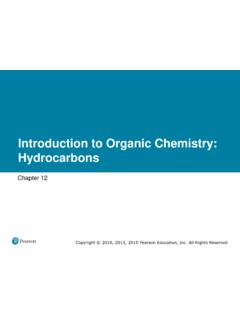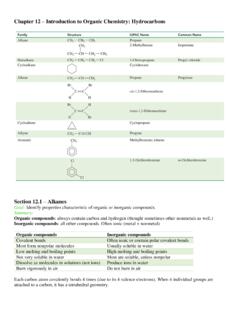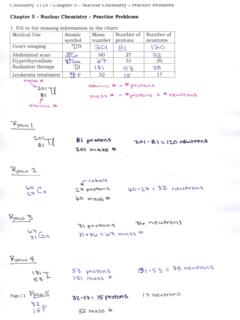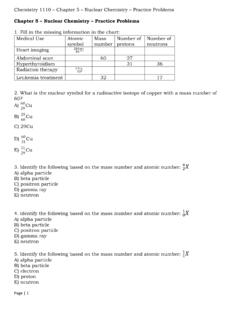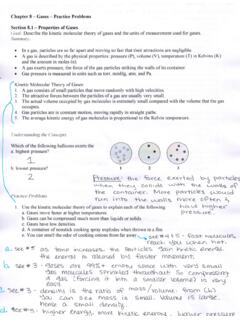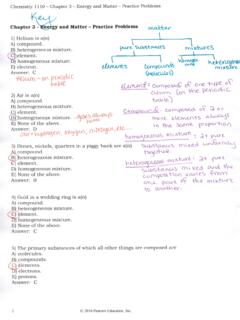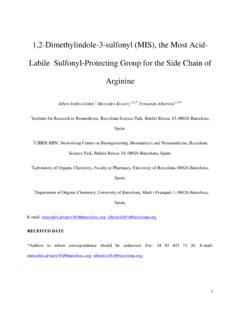Transcription of Chapter 3 Protecting Groups - chem.usu.edu
1 1 Chapter 3: Protecting Groups I. Protecting Groups of Hydroxyl Groups Consider the stability and effect of anomeric group ! Consider the solubility of starting material (the choice of solvent)! Consider the reactivity of different hydroxyl Groups ! * DCM is common for pyranoses with 2-3 OH s. For pyranose with more than 4 OH s, use DMF or pyridine. * Nucleophilicity of OH Groups on pyranoses (chair conformation) (Carbohydr. Res. 1987, 162, 159.) 1 OH > 2 OH Equatorial OH > axial OH Equatorial OH with vicinal axial OH (or OR) > Equatorial OH without vicinal axial OH (or OR) Examples: OOHHOHOHOOMe12346 Estimated order of nucleophilicity: 6-OH > 2-OH > 3-OH ~ 4-OH OOHHOHOHOOMe12346 Estimated order of nucleophilicity: 6-OH > 3-OH > 2-OH > 4-OH 2(i) Alkyl ether type SugOHSugOR Advantages: * Relatively stable in harsh conditions (acidic, basic, reflux, etc.)
2 * Enhance the reactivity of glycosylation due to electron-donating effect * More compatible to the conditions needed for deoxygenation or amino (azido) substitution * Selective protection is possible Disadvantages: * Relatively harder to remove (deprotect) * Conditions for protection and deprotection may not be compatible to other types of Protecting Groups (a) R = methyl (CH3, Me) * Not commonly used due to the difficulty of deprotection * Methoxy group can be found in naturally occurring unusual sugars Reagent/Condition Reference MeI, NaH in THF or DMF Tetrahedron Lett.
3 1989, 30, 641. Me3O+BF4- J. Org. Chem. 1972, 37, 912. MeOTf, DCM, py., 80 C Protection MeI, Ag2O J. Am. Chem. Soc. 1980, 102, 7083. BBr3, EtOAc or DCM J. Org. Chem. 1979, 44, 4863. SiCl4, NaH, DCM, CH3CN Synthesis 1982, 1048. AlCl3, AlBr3 Chem. Lett. 1979, 97. Deprotection Ac2O, FeCl3, 80 C J. Org. Chem. 1974, 39, 3728 Examples: OOOOHSPh77%OOHHOOCH3 SPh1) CH3I, NaH, THF2) AcOH, TFA, H2O 3(b) R = trityl, triphenylmethyl (Ph3C, Tr) * Excellent for selective protection of primary OH * Stable in basic but very labile in acidic conditions * Easy to observe with TLC * Deprotection can be tricky Reagent/Condition Reference Protection TrCl, 3 amines, DCM Tetrahedron Lett.
4 1989, 30, 641. TFA, t-BuOH Carbohydr. Res. 1978, 60, 206. HCl, CHCl3, 0 C Carbohydr. Res. 1971, 17, 439. TsOH, DCM, MeOH Tetrahedron Lett. 1977, 18, 3473. Deprotection BF3, Et2O Can. J. Chem. 1978, 56, 2700 Examples: 4(c) R = methoxymethyl (CH3 OCH2, MOM) * Can be incorporated at relatively weak basic conditions (3 amine) but needs relatively strong acid (TFA) to remove * Stable in basic conditions * The reagent, MOMCl, is considered carcinogenic Reagent/Condition Reference MOMCl, NaH in THF or DMF J. Am. Chem. Soc.
5 1972, 94, 7827. MOMCl, DIPEA, 0 C or - Synthesis 1975, 276. Protection CH2(OMe)2, TsOH, LiBr, Synthesis 1985, 74. Conc. HCl, MeOH Chem. Commun. 1974, 298. Me2 BBr, DCM J. Am. Chem. Soc. 1981, 103, 3213. TFA, DCM J. Am. Chem. Soc. 1981, 103, 3210. Deprotection LiBF4, CH3CN, 80 C J. Org. Chem. 1986, 51, 635. Examples: 5(d) R = benzyl (C6H5CH2, Bn) * Can be traceless removed using hydrogenolysis * Stable in basic conditions * Relatively stable in acidic conditions * Quenching excess reagent (BrBr) with MeOH can be tricky Reagent/Condition Reference BnCl, Bu4N+-HSO4-, KOH Tetrahedron Lett.
6 1975, 16, 3251. BnBr, NaH, THF or DMF, TBAI Tetrahedron Lett. 1976, 17, 3535. BnBr, Ag2O, DMF, Bull. Korean Chem. Soc. 2003, 24, 163. J. Org. Chem. 1985, 50, 3940. BnBr, Bu2 SnO or (Bu3Sn)2O, toluene, reflux J. Am. Chem. Soc. 1994, 116, 5647 Protection BnOC(NH)CCl3, TfOH J. Am. Chem. Soc. 1988, 110, 1624. Synthesis 1987, 568. H2, Pd/C or Pd(OH)2/C TMSI, DCM J. Org. Chem. 1977, 42, 3761. BF3-OEt2, NaI, CH3CN J. Chem. Res. Synop. 1985, 232. Ac2O, H2SO4, 0 C J. Org. Chem. 2004, 69, 1513. Deprotection FeCl3, DCM Tetrahedron: Asymmetry 1995, 857.
7 Examples: OHOOMeHOOOPh1) (n-Bu3Sn)2O2) BnBrOBnOOMeHOOOPh+OHOOMeBnOOOPh10 : 1 (Synthesis 1994, 1121) OHOOMeHOOOPhn-Bu4N+-HSO4-BnBr, NaOH, DCM+OHOOMeBnOOOPhOOBnOMeHOOOPh30%50% OHOOMeHOOOPhOBnOOMeHOOOPhn-Bu4N+-HSO4-Bn Br, NaOH, DCM50% (Org. Lett. 2004, 6, 1365) 6(e) R = p-methoxybenzyl (CH3OC6H4CH2, PMB) * More prone to oxidative cleavage than Bn but less prone to reductive cleavage than Bn * Stable in basic conditions * Relatively stable in acidic conditions Reagent/Condition Reference PMBCl, NaH, THF or DMF J.
8 Org. Chem. 1984, 49, 51. PMBOC(NH)CCl3, TfOH Tetrahedron Lett. 1988, 29, 4139. Tetrahedron Lett. 1983, 24, 5364. Protection (NH3)2Ce(NO2)6, Ceric ammonium nitrate (CAN), CH3CN, H2O DDQ, DCM J. Am. Chem. Soc. 1985, 107, 4586. Deprotection 7(f) R = tetrahydropyranyl (THP) * Stability similar to glycosidic bond * Stable in basic conditions Reagent/Condition Reference Dihydropyran, TsOH, DCM J. Org. Chem. 1979, 44, 1438. Protection Dihydropyran, PPTS, DCM J. Org. Chem. 1977, 42, 3772. HOAc, THF, H2O J. Org. Chem. 1979, 44, 1438.
9 PPTS, EtOH, 55 C J. Org. Chem. 1977, 42, 3772. TsOH, MeOH, J. Am. Chem. Soc. 1978, 100, 1942. Deprotection MgBr2, Et2O, Tetrahedron Lett. 1987, 28, 439. Examples: (ii) Silyl ether type SugOHSugOSiR3R3 SiX++NR'3NR'3HX+ * Stability varies General reagents for protection: R3 SiX with 3 amines (DIPEA, TEA, immidazole, lutidine, pyridine, etc) Common reagents for deprotection: TBAF, BF3, KF, or pyridine-HF Trimethylsilyl (TMS) Can be cleaved with K2CO3, MeOH or citric acid Triethylsilyl (TES) Can be cleaved with HOAc Triisopropylsilyl (TIPS) Possible for selective protection of 1 OH t-Butyldimethylsilyl (TBS) Selective protection of 1 OH t-Butyldiphenylsilyl (TBDPS) Selective protection of 1 OH Relatively stable in basic condition 8(iii) Ester type SugOH+CXORSugOCRO+HX (a) R = trifluoroacetyl (TFA) General reagent for protection: trifluoroacetic anhydride with 3 amines (DIPEA, TEA, immidazole, lutidine, pyridine etc), DMAP as catalyst Common reagent for deprotection.
10 Weak acids or bases (b) R = acetyl (Ac) General reagents for protection: Ac2O with 3 amines (DIPEA, TEA, immidazole, lutidine, pyridine etc) or Ac2O with cat. acids. Common reagents for deprotection: K2CO3, MeOH, cat. NaOMe in MeOH, or LiOH, THF, H2O (J. Org. Chem. 2004, 69, 1513) * anomeric acetyl group can be selectively removed with H2 NNH2-HOAc or BnNH2 Examples: 9(c) R = trimethylacetyl (Piv) * Can be used for selective protection General reagent for protection: pivaloyl chloride (PivCl) with 3 amines (DIPEA, TEA, pyridine etc) Reagent/Condition Reference Bu4N+OH-, Tetrahedron Lett.
